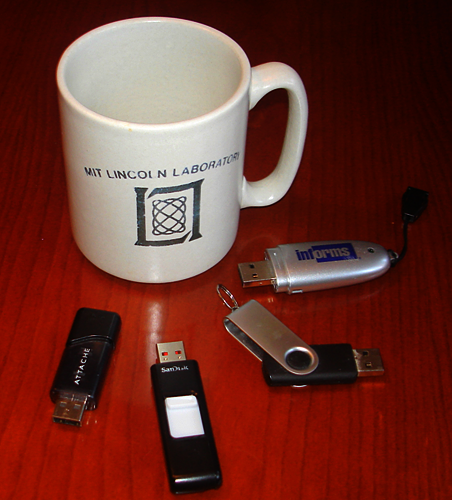Flash Memory
by Andrew Boyd
Today, better memory. The University of Houston's College of Engineering presents this series about the machines that make our civilization run, and the people whose ingenuity created them.
It seems everyone owns a handful or so. They're found on key chains or rattling loosely in pockets or purses. Conference organizers like to give them as gifts. They're flash drives, those thumb size devices we stick in our computers to share files or PowerPoint presentations. And the technology behind them is changing the face of computing.

Computers store data on all sorts of devices, but two of the most important — which you run into when buying a computer — are memory and the hard disk. Memory resides on computer chips and has no moving parts. A hard disk, on the other hand, is a whirling circle of metal with a precisely engineered arm that reads and writes information on the disk. The set up's surprisingly similar to an old record player.

Reading and writing on hard disks is much slower than reading and writing to memory. But hard disks are less expensive and, very importantly, information that's stored on them doesn't disappear when your computer's turned off. That's not true of most of your computer's memory, which goes as blank as a TV screen without power.
But there are types of memory that don't require power. In the early eighties Toshiba developed what we now call flash memory. It was first made available in 1987, though it wasn't until the year 2000 that it found its way into flash drives. The drives weren't immediately popular for the simple reason that they were expensive. At the end of 2004, the magazine Computerworld had one flash drive listed for over $400. Today, you can get one with four times as much memory for under $10.
With prices like that flash drives have stormed the market. But while these tiny drives are the most visible manifestation of what can be done with flash memory, the real miracles are taking place inside our electronic gadgets. And there's one main reason. Unlike hard disk drives, flash memory is solid-state — it has no moving parts. Shake a hard disk around and you can easily damage it. Not so with flash memory. And that makes it perfect for mobile devices. Music players. Cell phones. Tablet computers. The dizzying ability to carry thousands of songs, pictures, and apps is thanks to flash memory.
Flash memory isn't the answer to everything. It's slower than other kinds of memory. And it can actually wear out. The process by which is stores information slowly causes physical damage to the chip. That's not true of memory that loses information when turned off. So this more commonly used memory isn't likely to be replaced anytime soon. But hard disks may have ultimately met their match. Flash memory's one of the hottest technologies going. And in a world that seems ever more intent on taking technology with us wherever we go, flash memory is ideally suited for the long and bumpy road.
I'm Andy Boyd at the University of Houston, where we're interested in the way inventive minds work.
(Theme music)
Notes and references:
For a related episode, see COMPUTER MEMORY.
There exist many different types of computer memory, with a distinction made between volatile memory (memory that requires a power source to maintain information) and non-volatile memory (memory that can maintain information without a power source). Volatile memory historically has been known as RAM (for Random Access Memory) and non-volatile memory as ROM (for Read Only Memory). In early chip design, maintaining information without a power source meant no reading and writing to a memory chip, only reading. The RAM and ROM acronyms linger, but now lead to some confusion. For example, flash memory is classified as a form of EEPROM, for Electronically Erasable Programmable Read Only Memory. However, it's clearly not read only memory since it was designed with the intention of reading and writing to it many times.
R. Kay. Flash Memory. Computerworld, June 7, 2010. See also: http://www.computerworld.com/s/article/349425/Flash_Memory. Accessed October 9, 2012.
C. Preimesberger. Data Storage: NAND Flash Memory: 25 Years of Invention, Development. eWeek, April 11, 2012. .
Read Only Memory. From the Wikipedia website: https://en.wikipedia.org/wiki/Read_only_memory. Accessed October 9, 2012.
The picture of the hard disk is by Gary Stevens of Hosting Canada.
The picture of the flash disks and coffee mug is by E. A. Boyd.
This episode was first aired on October 11, 2012
